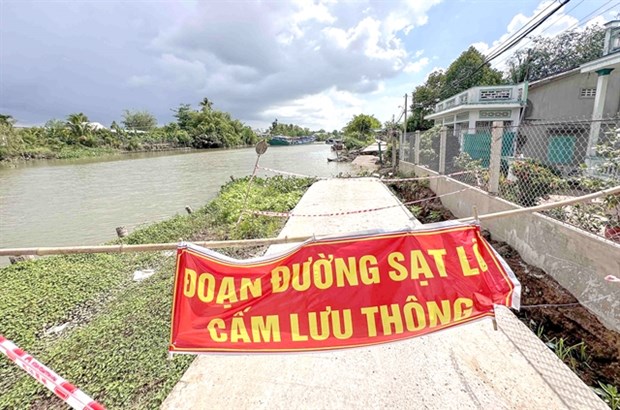
Erosion damages a road along the Tra Noc River in Thoi An Dong commune of Binh Thuy district, Can Tho city (Photo: VNA)
On May 23, leaders of the municipal People’s Committee inspected erosion along O Mon River in Thoi Lai district and Tra Noc River in Binh Thuy district.
The O Mon River in Thoi Phuoc 1 hamlet in Thoi Lai district’s Tan Thanh commune was eroded along a section 55 metres long and eight metres wide on May 20, causing a four-metre wide section of road to fall into the river and block travel.
Previously, on April 2, the area was eroded in a section of 58 metre length. After the incident, local authorities installed barriers to ban people entering the eroded area, and used cajuput stakes and plastic sheets to temporarily repair it.
The O Mon River’s section in Thoi Lai town’s Thoi Hoa A hamlet in Thoi Lai district was eroded in a section 30 metres long and impacted the travel of people. The Thoi Lai People’s Committee has temporarily repaired the eroded area to secure travel.
Nguyen Thanh Ut, Chairman of the Thoi Lai District People’s Committee, said that while waiting for the city People’s Committee’s plan of building concrete erosion prevention embankments in the two eroded areas, the district has decided to build two urgent embankments at a cost of 2 billion VND (85,000 USD).
He petitioned the municipal People’s Committee and the city’s steering committee for climate change response, natural disaster prevention and control, and civil defence to allocate funds to repair the district’s eroded areas.
He also petitioned the city People’s Committee to have a plan to build 13 erosion prevention projects with a total length of 7.1 km along the O Mon River, areas which have high erosion risk.
The Binh Thuy District People’s Committee petitioned the city People’s Committee to allocate funds to repair erosion along the Tra Noc River in Thoi Thuan area in Thoi An Dong commune.
The Thoi Thuan area was eroded in a section 100 metres long and 50 metres wide, damaging the road along the river and blocking travel.
Nguyen Ngoc He, Vice Chairman of the city People’s Committee, asked local authorities and the two districts’ steering committees for climate change response, natural disaster prevention and control, and civil defence to inspect the installation of barriers and ropes in eroded areas to warn people.
Local authorities and the steering committees should create safe temporary paths for travel and encourage households to move their construction works and fences out of eroded and erosion-prone areas, he said.
The province’s Irrigation Sub-department should collect the petitions of localities and consult the city People’s Committee to allocate funds to repair eroded areas, he said.
Localities should inspect erosion along rivers and canals at the beginning of the rainy season, encourage households living in erosion prone areas to move to safe areas, and take erosion prevention measures such as building temporary or biological embankments, he said.
The city has taken various measures, including building embankments, to prevent and mitigate the damage of erosion along rivers and canals in past years.
It had 262 erosion cases along a total length of 9.8km of rivers and canals in 2010-2022, causing four deaths and five injured and damaging 94 houses, according to the department.
The major reasons for the erosion were the changes in water flow at bends in rivers and canals, weak banks, illegal construction of infrastructure and houses along banks, use of boats, excessive mining of sand and the reduction of sediment deposits in the Mekong River./.
VNA
